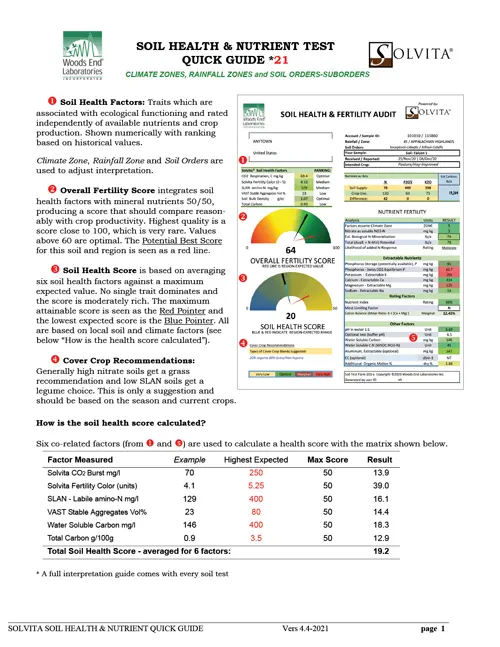Measure More Than Just Nutrients
Soil Nutrient Testing – See a Bigger Picture with a Soil Quality Audit
Woods End started offering a comprehensive “Soil Quality Audit” sometime around 1988 – a test which which combined physical, biological and nutrient tests in a single report. This was perhaps the first test offering in the USA of what today is popularly called “soil health” analysis. The test was not our own invention- but followed from pioneering work in Europe to create a framework for evaluating “biological farming”.
Soil health is a challenge to soil scientists and testing labs since it refers to a quality as much as a quantity. Soil health does not come from any single property. Rather it emerges from the interaction of many. This is why it has eluded “scientific” discovery for so long.
In a way, soil health is like soil taxonomy – it varies with climate zone and soil types. But more than taxonomy, soil health allows for a unifying element: life (biology) itself. Using this as a premise, Woods End labs has designed a lab process that integrates intrinsic soil traits with “eco-physiography” – major soil zones down to rainfall and climate – in a unified evaluation: a work in progress.
Woods End approach is bring together both quantitative and qualitative factors that relate to healthy functioning. Added to that, we’ve accounted for how soil is handled in sampling and processing, understanding the evidence that exists that the manner in which soils are processed before and during testing also influences the results.
Cornerstones of How We Do It:
- We identify your place – we believe a soil health report can’t be interpreted without knowing the actual location. You’ll see SSURGO soil classes appear on your report along with the national eco-zone designation!
- We use biological assays – innovative tools evaluate such critical soil health factors as microbial carbon respiration (a test our lab has 40 years of experience with) and accumulation of amino nitrogen indicating the quality of humus and favorable crop-rotations.
- We include bio-physical traits – our water-stable aggregate (“VAST”) method enables exciting visual and quantitative evaluation of erosion-sensitivity and soil-porosity that is due to microbial and plant presence.
- We minimize sample disturbance – no grinders or mills are used which disrupt bio-physical features relevant to soil biological tests. We’ve revived soil rolling, a traditional art once used to prep soils but unfortunately discontinued due to modernization of labs.
1- Premium Soil Health Test
- Evaluates quality and not just quantity of soil organic matter.
- Accounts for soil microbial biomass via respiration instead of indirect chemical measures;
- Evaluates nutrient mineralization potential, the core of the nutrient supply mechanism for plants
- Represents nutrients likely to be “plant relevant” from lighter-weight extractants (NOT the Haney Test!)
- NEW: you can choose between Organic Matter or Total Carbon – or add Total Carbon to your Premium! Learn more
2- Basic Soil Health
- Our basic soil health test is meant to be a companion to common soil nutrient analyses obtained elsewhere or through your favorite soil lab. The basic adds information about biological and bio-physical traits that are not available elsewhere. Included is Solvita CO2, Solvita Labile-Amino-N, Water Stable Aggregates, Soil C:N ratio, and Respiratory Quotient.
With every soil sample, you will receive a full-page report giving a Fertility Score and a Soil Health Score, along with a 4-page interpretation guideline explaining the test concepts and the ranges expected.
The Soil Health Score weighs multiple attributes associated with biological functioning in soils, while the Fertility Score integrates this with the nutrient status. Why do this? Because we know you can have a healthy soil with deficient nutrients, or you can have a nutrient-rich soil which is in poor health. This helps you better understand your situation and helps us make better suggestions for you.
3- New in 2020
- Total Carbon Test – Learn More
- We offer Farm Spatial Variability Testing (Soil Texture Test: Sand, Silt, Clay) to design a sampling program to improve soil test reliability. Read more
Here’s just a few unique features of our report:
- Nitrogen-mineralization estimation – we combine biological tests and climate zone ranking to give you a realistic estimate of the amount of N your soil will contribute without fertilizer.
- Likelihood of N-response – this is a special test that we’ve developed which estimates the probability that your crop will respond to added nitrogen. This helps inform your decisions and potentially save money on N.
- Soil phosphorus equilibrium – in addition to showing your reserve phosphorus (Mehlich-1) we offer a unique test coming from Europe that shows your soil’s ability to push phosphorus from fixed into available form. Think of it as likelihood of P-response, a test that may help save unnecessary P-fertilization and cost.
- Cation Balance – If you grow covers crops and are grazing animals, excessive potassium can be a serious risk – we show the molecular balance of K: (Ca+Mg) to guide you here.
Please provide the following:
- The soil sample: (wet or dry) in a quart sized zip-lock bag, with the date of the sample and the intended crops. If the location is different than the zip code on the order, please provide specific GPS or sample zip code information which we use to map to your climate zone.
- Sample Information Form: Please attach the following Sample-information with each order.

